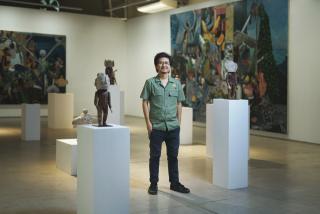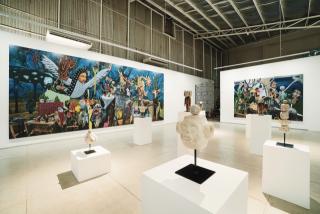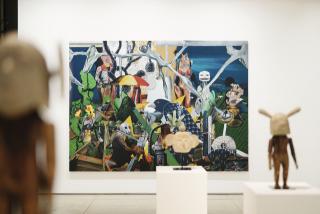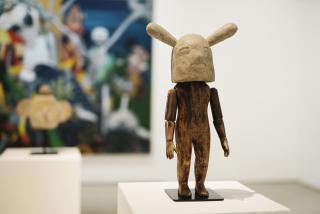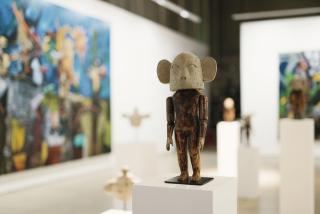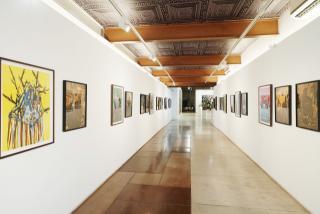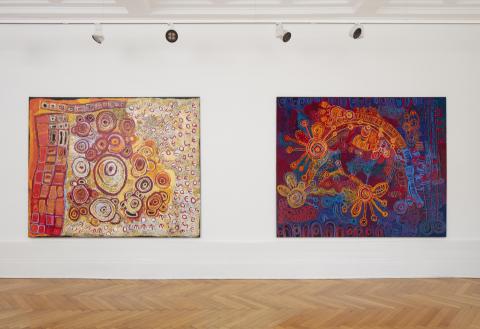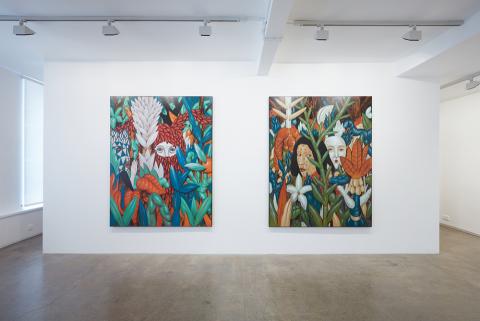Rodel Tapaya
Rodel Tapaya: May Tenga ang Lupa
Solo Exhibition
Exhibition Dates: 14 June - 9 July, 2022
Exhibition Dates: 14 June - 9 July, 2022
Arndt Art Agency is pleased to announce Rodel Tapaya's solo exhibition at The Drawing Room, Manila.
May tenga ang lupa, may pakpak ang balita (The land has ears, the news has wings) is an aphorism that reminds us not only that contemporary realities have ancient roots but also that nonhuman actors matter in telling the story. In Rodel Tapaya’s own words, it is these stories that give us existence: “… myths and folktales are our ancestors”. The labyrinthine genealogy of folklore runs through these paintings to show us the fine line that separates imagination and falsehood. These works occasion contemplation of how massive disinformation is built upon a maze of folklorism that confuses our way of interpreting and remembering.
While the word tenga commonly means ‘ears’ in Tagalog, in other Austronesian languages, it also means ‘center or middle’. Later on, it came to mean the half of a particular whole or the curve of a street or landscape. The word tenga thus points to the centrality of the organ of hearing and balance to the corporeal and environmental conception of our ancestors. (1)
The idea that even animals and objects can listen and transmit private thoughts endures in our current age of surveillance capitalism; a time when unregulated social media increasingly threatens human autonomy and civil society. The works in this exhibition offer a glimpse into this unfolding crisis by retelling the version of events from history but in the shape of fables where animals take on human roles and plead with the reader to uncover the truth from the satire.
The main figure in the painting is Macario Sakay, who commanded the remnants of the revolutionary forces during the Philippine-American War. Sakay anticipated how the battle would rage on long after they were dead in the frontier of historical revisionism. Here, he is reimagined with eyes in his long hair and spread out wings that recall the iconic gesture of the man in Goya’s Third of May, 1808. Like that man, Sakay remained defiant in the face of execution. His face in this painting shows anguish that is more worried than terrified. Asserting his humanity, Sakay stood in the gallows and appealed to fellow prisoners: “But I want to tell you that we are not bandits and robbers, as the Americans have accused us, but members of the revolutionary forces that defended our mother country.” By painting Sakay as a bird of freedom and political awakening, the painter carries out the aspiration in his last words: “May our independence be born in the future”.
(1) In some Tagalog translations of the Bible, it replaces the penultimate verses of Ecclesiastes 10 (..a bird on the wing may report what you say).
Photography credit: Anjo Lapresca
May tenga ang lupa, may pakpak ang balita (The land has ears, the news has wings) is an aphorism that reminds us not only that contemporary realities have ancient roots but also that nonhuman actors matter in telling the story. In Rodel Tapaya’s own words, it is these stories that give us existence: “… myths and folktales are our ancestors”. The labyrinthine genealogy of folklore runs through these paintings to show us the fine line that separates imagination and falsehood. These works occasion contemplation of how massive disinformation is built upon a maze of folklorism that confuses our way of interpreting and remembering.
While the word tenga commonly means ‘ears’ in Tagalog, in other Austronesian languages, it also means ‘center or middle’. Later on, it came to mean the half of a particular whole or the curve of a street or landscape. The word tenga thus points to the centrality of the organ of hearing and balance to the corporeal and environmental conception of our ancestors. (1)
The idea that even animals and objects can listen and transmit private thoughts endures in our current age of surveillance capitalism; a time when unregulated social media increasingly threatens human autonomy and civil society. The works in this exhibition offer a glimpse into this unfolding crisis by retelling the version of events from history but in the shape of fables where animals take on human roles and plead with the reader to uncover the truth from the satire.
The main figure in the painting is Macario Sakay, who commanded the remnants of the revolutionary forces during the Philippine-American War. Sakay anticipated how the battle would rage on long after they were dead in the frontier of historical revisionism. Here, he is reimagined with eyes in his long hair and spread out wings that recall the iconic gesture of the man in Goya’s Third of May, 1808. Like that man, Sakay remained defiant in the face of execution. His face in this painting shows anguish that is more worried than terrified. Asserting his humanity, Sakay stood in the gallows and appealed to fellow prisoners: “But I want to tell you that we are not bandits and robbers, as the Americans have accused us, but members of the revolutionary forces that defended our mother country.” By painting Sakay as a bird of freedom and political awakening, the painter carries out the aspiration in his last words: “May our independence be born in the future”.
(1) In some Tagalog translations of the Bible, it replaces the penultimate verses of Ecclesiastes 10 (..a bird on the wing may report what you say).
Photography credit: Anjo Lapresca
